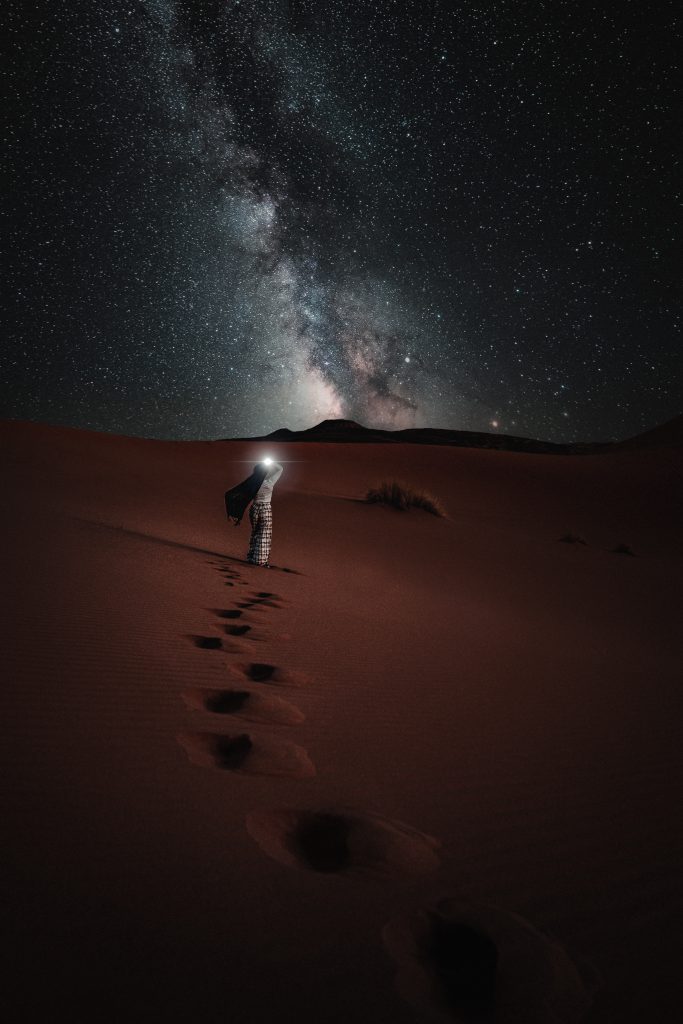Stargazing in the Sahara desert
During his visit to the Moroccan part of the Sahara desert, Canadian photographer Zack Fex rode on camels, camped in the desert and shot many beautiful pictures of the cosmos.
About The Sahara Desert in Merzouga
The Sahara desert is the world’s largest desert. It covers large sections of the North African continent – in total it spans over 11 countries: Algeria, Chad, Egypt, Libya, Mali, Mauritania, Morocco, Niger, Western Sahara, Sudan, and Tunisia.
The most famous Moroccan village in the Sahara desert is Merzouga, because it is the closest city to the desert and the Erg Chebbi sand dunes, making the Sahara desert very easy to access for tourists. Additionally, these dunes in this region rise to 150 meters high, making them the perfect spot for fantastic adventures: From sleeping under the stars and witnessing a stunning sunrise, to exploring these dunes with 4x4s and camels.



The Erg Chebbi dunes even have their own urban legend! It’s said that after a wealthy family denied a poor woman accommodation and hospitality, after which God buried the family under mountains of sand. Which is why the sand-dunes are that high.
Tips for visiting The Sahara Desert in 2021
We asked Zack about this experiences in Africa, and this is what he had to say:
“During our trip to Morocco we discovered the Djebel Toubkal mountains, the Sahara desert and both the Mediterranean Sea and Atlantic Ocean. It’s safe to say the country contains a lot of beautiful places, which are all so different from each other.
In Merzouga we went on a camel-riding tour to discover the Sahara Desert, where we rode the camel the entire day. At night we went to a high-end campsite in the middle of the desert. [It was a] tricky experience, because despite many people thinking the Sahara desert has a constant hot climate, temperatures drop drastically at night and can even reach the freezing point. So during our trip it was about 20 degrees outside during the day… but at night it’s shockingly cold!
The Sahara desert isn’t surrounded by big cities, which makes it a prime stargazing location since it’s not polluted by city lights or exhaust gases. Honestly? I was amazed by how clear the stars appeared above us, and how big and bright some of them seemed to be.”



About the shot
When asking Zack about the tools and techniques he used to capture the galaxy in such a unique way, he unveiled that both his Gobe polarizer filter and his mid-aperture technique helped him nail the shot.
“My key tips for taking a stunning landscape picture? Well, I’ve been using a polarizer filter from a company called Gobe (@mygobe), which I absolutely love! For the aspiring photographers who aren’t using any yet: these filters can help you balance your highlights and shadows. When you’re trying to capture dramatic skies, or the subtle texture of water without the glare, the filter will help you achieve better results as well!
Another thing I do is shooting landscapes in mid-aperture in order to have everything in focus in my frame. I also want my image to be as sharp as when I have my aperture completely open like f2.8! That’s why I try to always shoot my landscapes between f8 and f11”.
These were the tools and settings used to achieve this specific picture.
Gear
Settings
- Shutter speed: 1/320
- ISO: 320
- Aperture: f/3.5
Software
About the Zack Fex
Zack Fex is a 19-year-old travel photographer and filmmaker from Canada. He has been traveling around the world for 2 years now, with the goal of showing the beauty of this planet through his lens.
Save for later …









